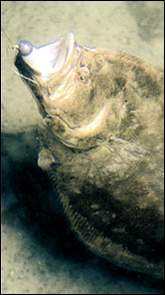|
 For unusually large flatfish, it pays to employ some unusual tactics in places you wouldn't usually suspect. Here, from our resident flounder fishing fanatic, are some proven off-the-wall techniques for on-the-wall trophies.
For unusually large flatfish, it pays to employ some unusual tactics in places you wouldn't usually suspect. Here, from our resident flounder fishing fanatic, are some proven off-the-wall techniques for on-the-wall trophies.
By Chester Moore, Jr.
Big flounder don't come easy.
Sure, plenty of saddle blanket-sized flatfish are caught by anglers who happen to be in the right place at the right time. But to specifically target really big flounder requires an intimate look at flounder behavior and the willingness to try techniques that may seem a little off-the-cuff.
 The usual procedure for fall flounder fishing involves targeting shallow, marshy cuts and inlets. However, purposely pursuing the big ones means trying some different methods including fishing structure related to deep water. The usual procedure for fall flounder fishing involves targeting shallow, marshy cuts and inlets. However, purposely pursuing the big ones means trying some different methods including fishing structure related to deep water.
How deep? Last year the Louisiana state record for flounder was broken by an angler fishing for snapper in 200 feet of water in the Gulf of Mexico. That's an extreme example, but it validates what scientists have said for many years. That big flounder the bona fide wallhangers prefer deeper water than do small and medium-sized ones.
The section of ship channel between a bay system and the Gulf is where many of the largest flounder will be. Shrimpers who have dragged these areas can validate that contention by the amount of big flounder bycatch that ends up in their nets while trawling the deeper climes.
Targeting these deep-water flatfish requires electronics. There are, after all, no openly visible markers to go by. Underwater, however, there are plenty of signs that point to possible flounder "holds" or areas in which the fish congregate.
The ideal flounder hold is a small spot or shelf on the edge of a steep drop-off. This hold might be a 20-square-foot area in 15 feet of water that borders a 30-foot drop-off. In most situations the 15-foot zone will gradually get shallower as you move toward the bank, but then drop off suddenly into the main channel.
Such shallow-to-deep scenarios provide a specific zone in which flounder can feed on baitfish that might also be attracted to this spot. Furthermore, such an area provides the flatfish a place in which to trade between the deeper main channel and the shallower shoreline.
After locating such a spot, fishing it is the second challenge. Position the boat so the anchor is right on the edge of the hold and you can fish straight up-and-down.
Tackle-wise, I usually recommend a good spinning combo for flounder fishing, but in this situation a stout casting rod and a trout-caliber baitcasting reel spooled to the brim with a "superline" like Berkley Fireline, Fusion, or SpiderWire braid is best.
The terminal rig is simple. It consists of only a 1-1/2- or 2-ounce jig head. Finding such specialized jig heads may require visiting a top-end tackle store like Cut-Rate Fishing Tackle in Houston, but the trip is well worth the effort.
On this jig head I use live mullet up to 8 inches long or some of the larger croaker you can buy from bait camps. There are very few small flounder in these spots, so don't be afraid to use a big bait. I once saw a 3-pound flounder get hooked on a foot-long mullet that was being used as alligator gar bait.
Once you've baited the jig head, simply lower it down over the spot, allow it to sink to the bottom and start jigging it up and down. If the flounder are there they usually hit pretty fast, so if you don't get a bite within 10 minutes move elsewhere.
It's really that simple.
continued
page 1 / page 2
| 




